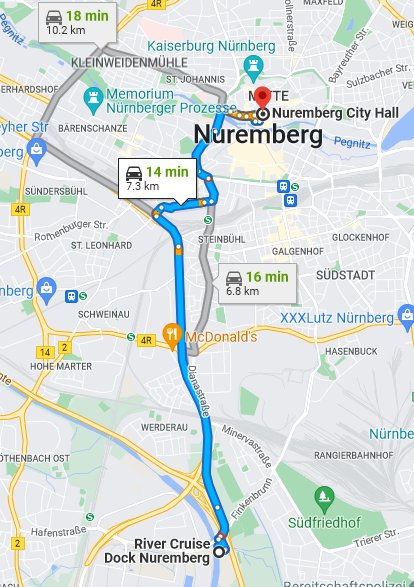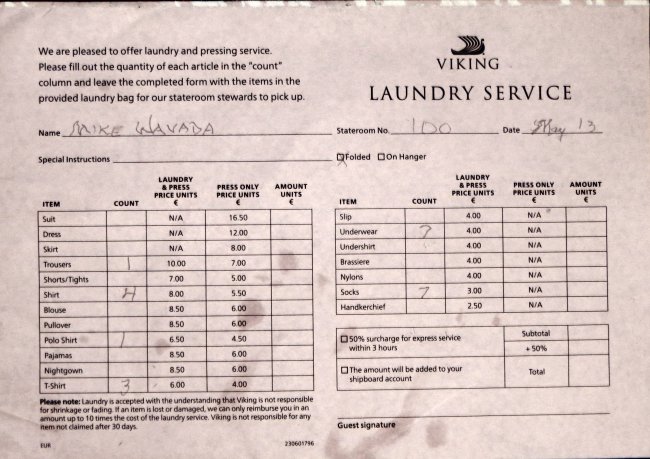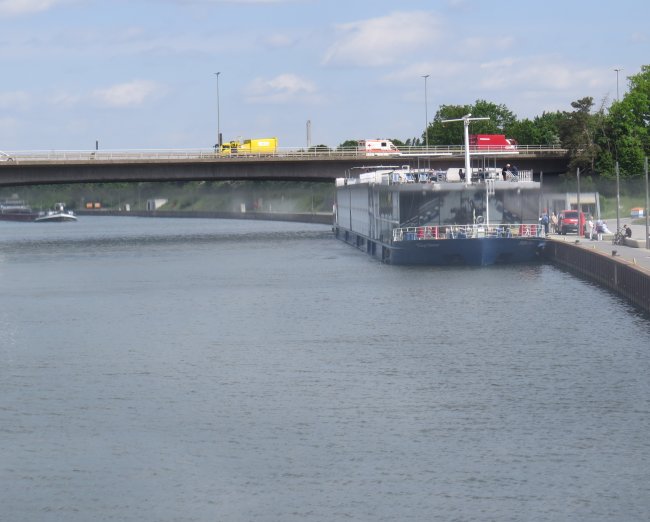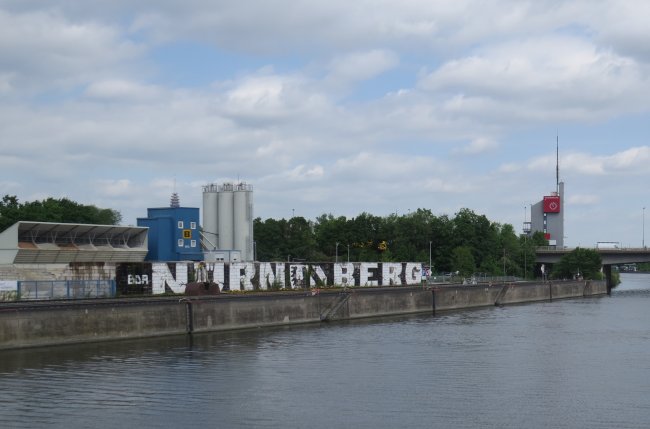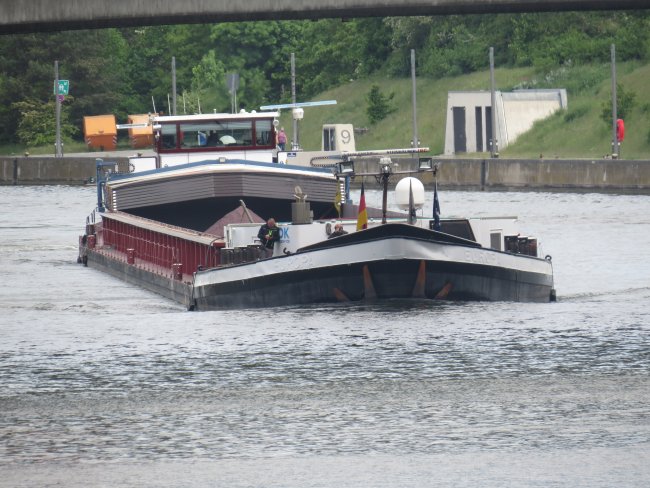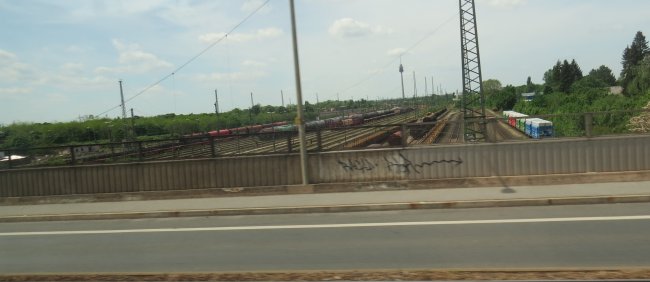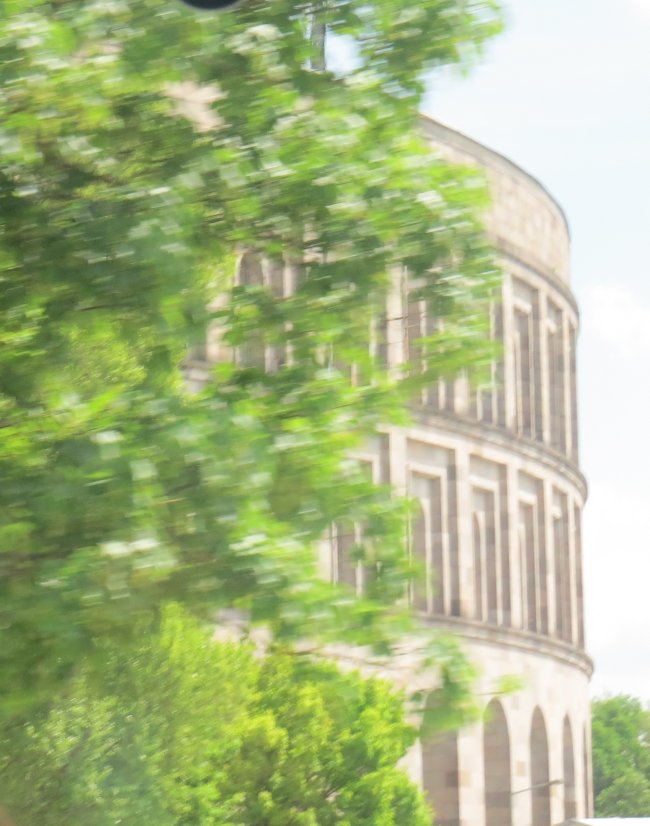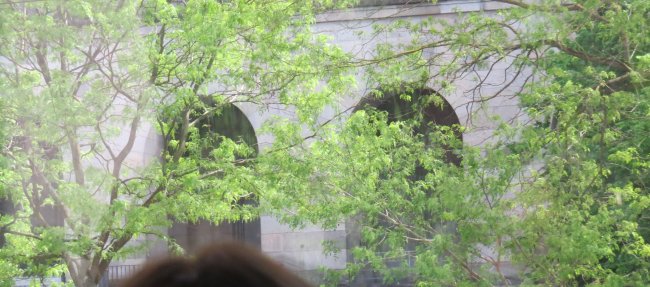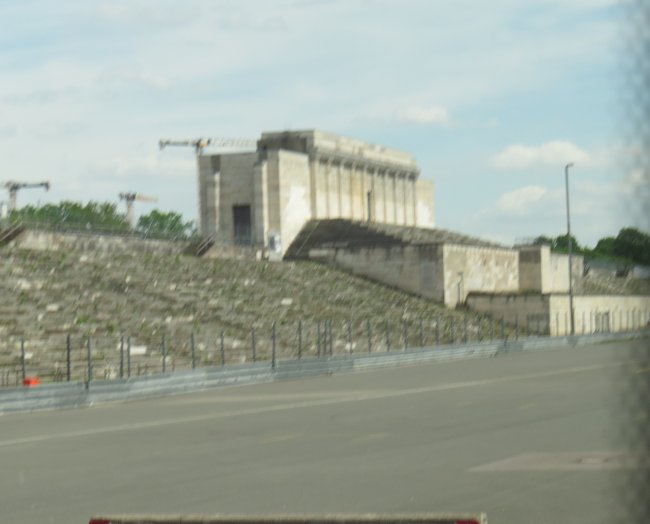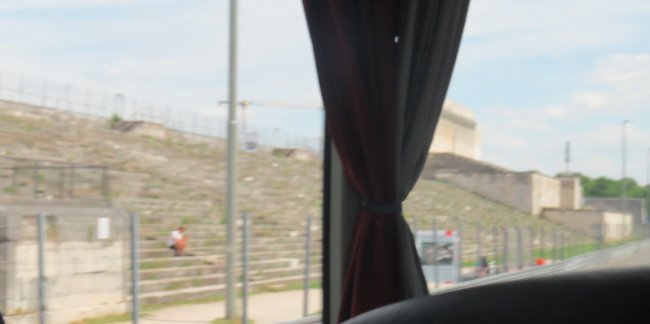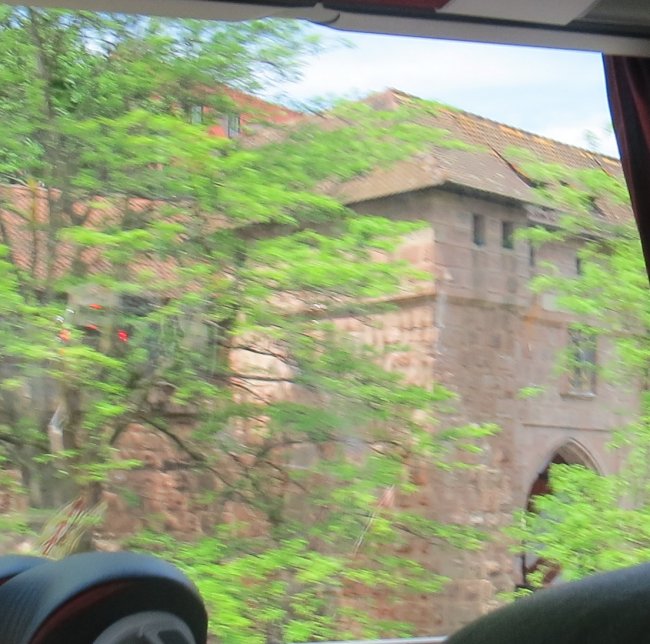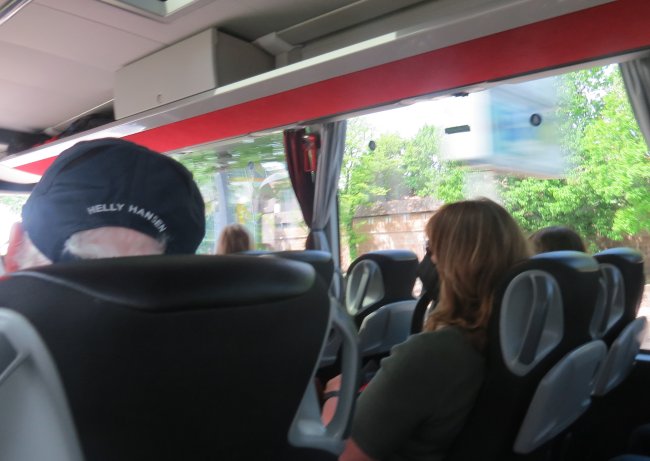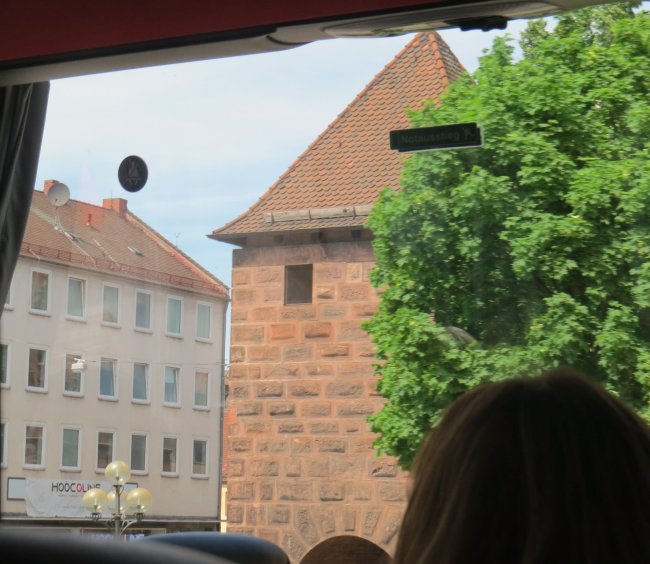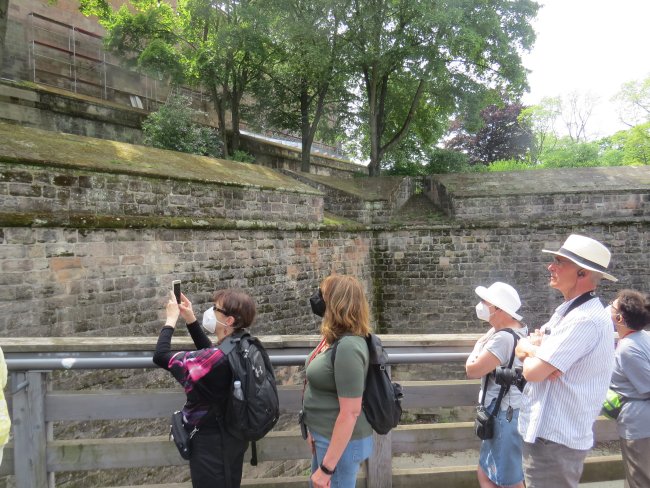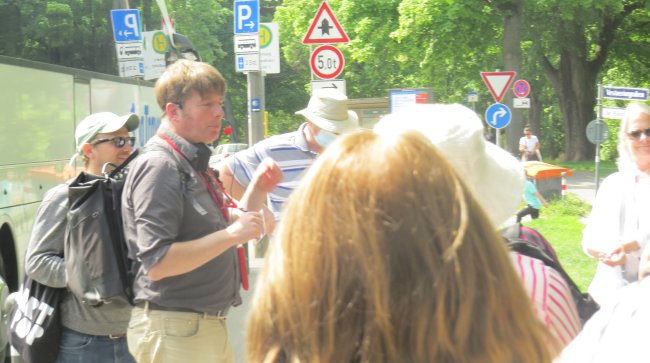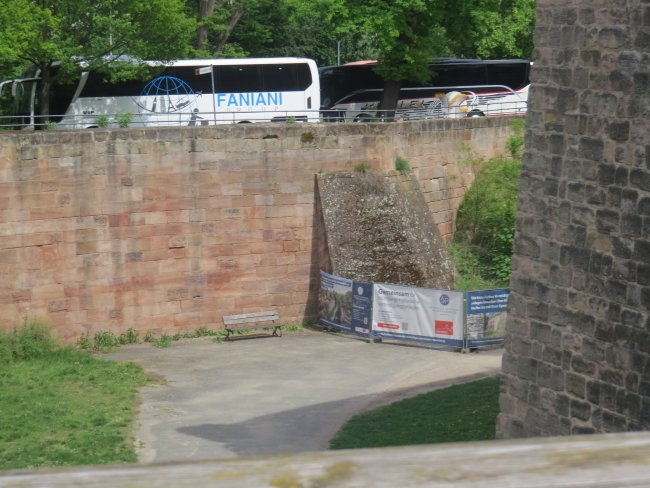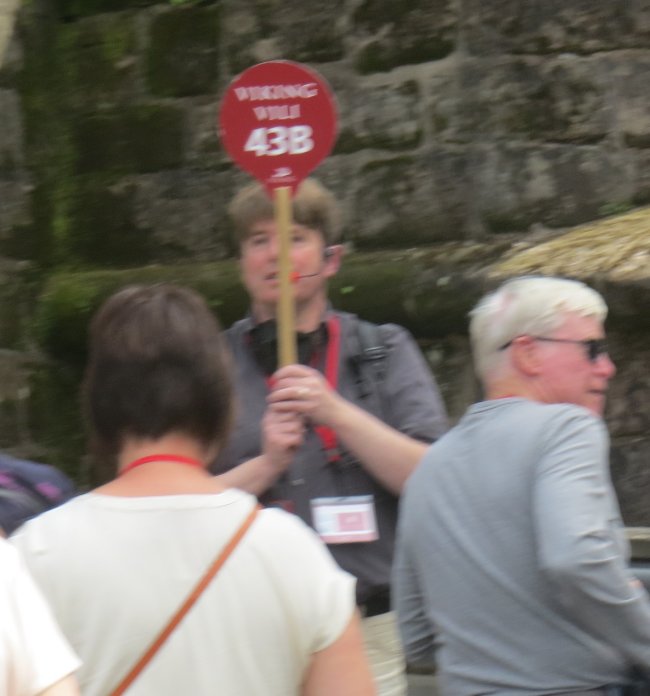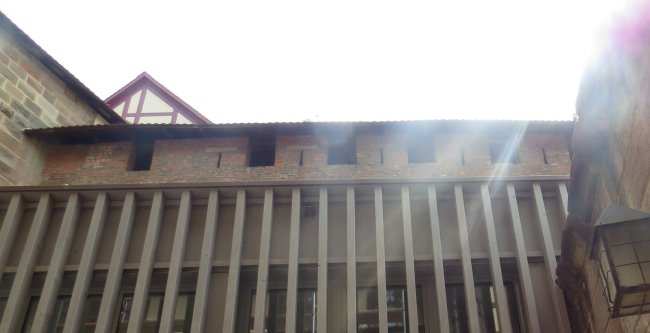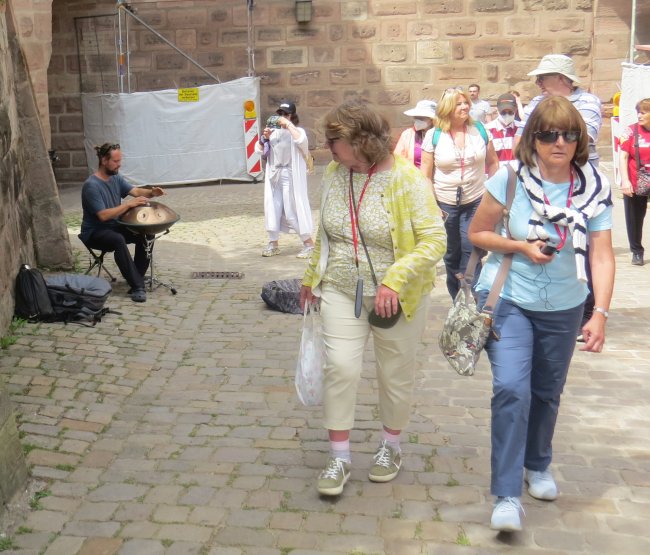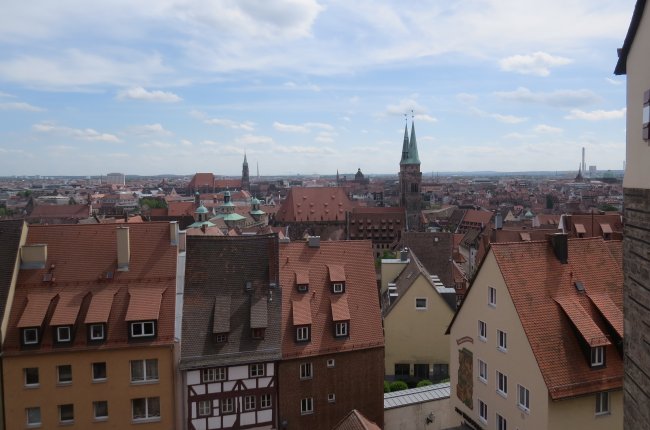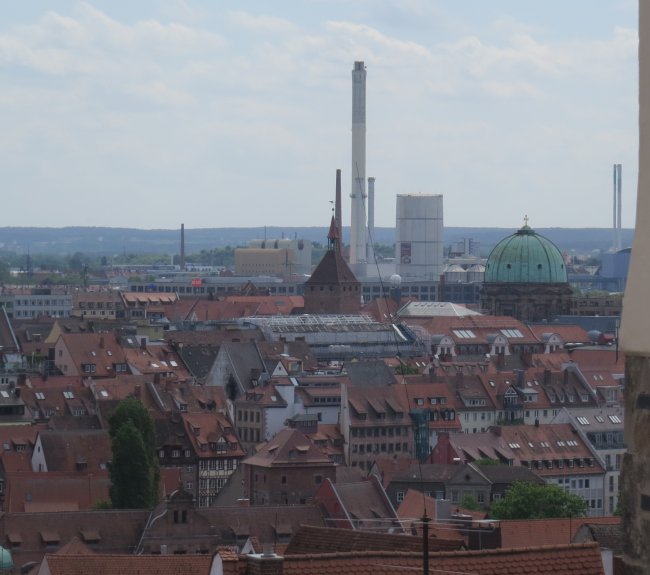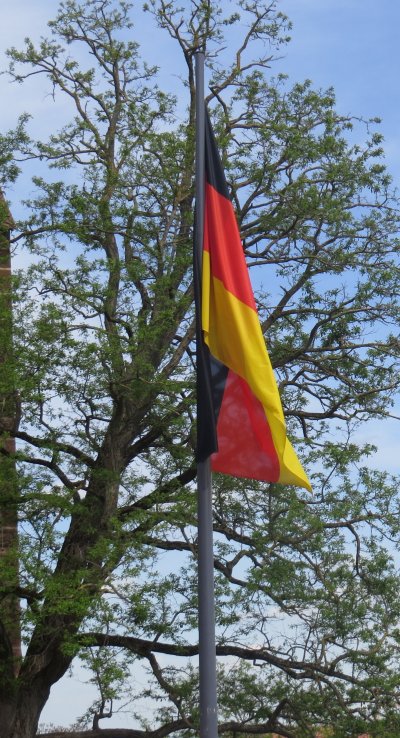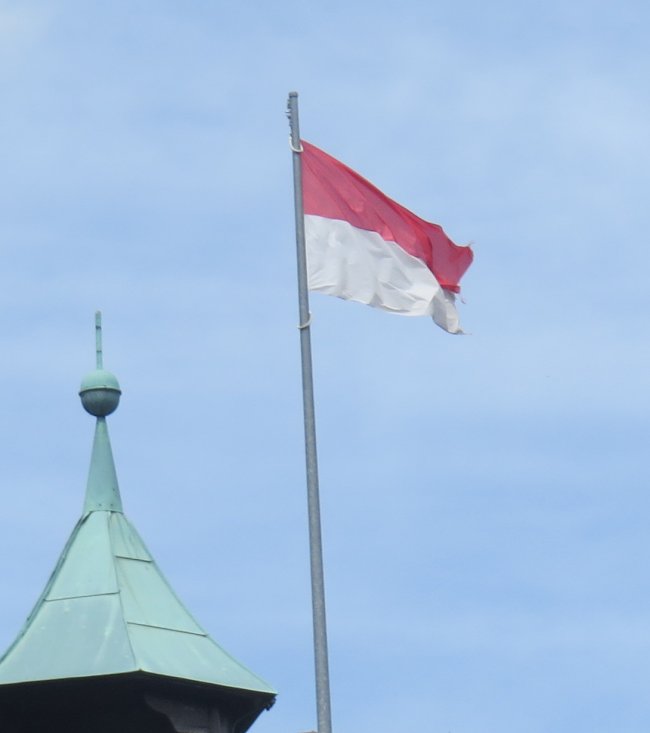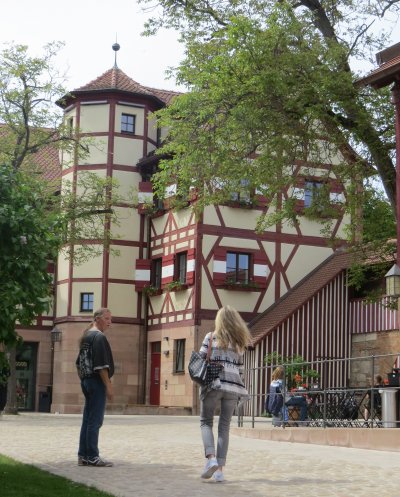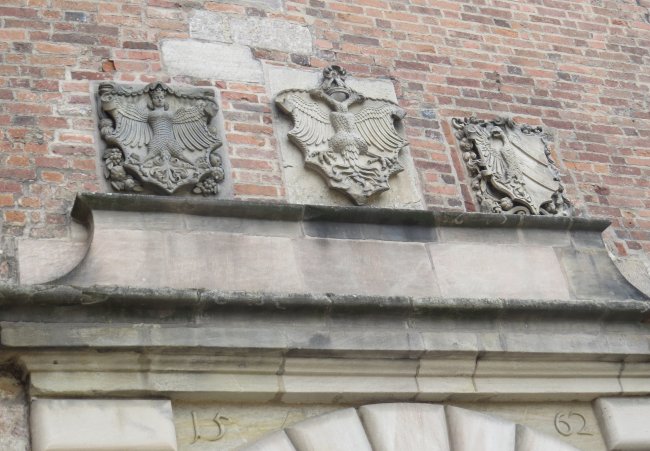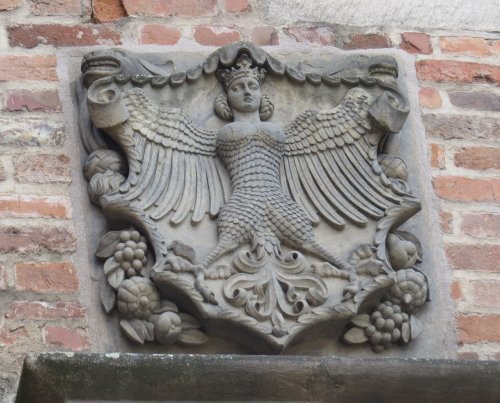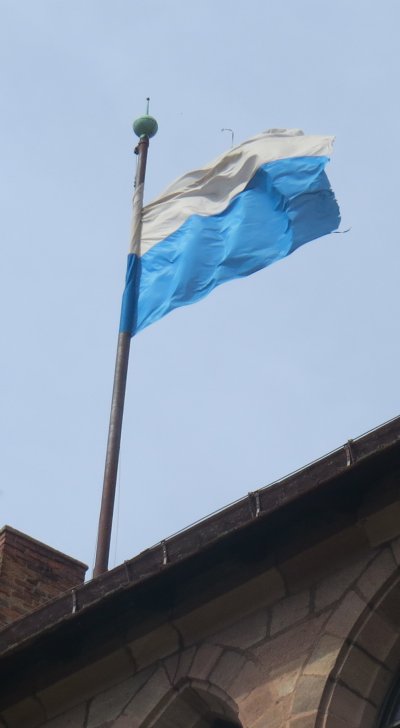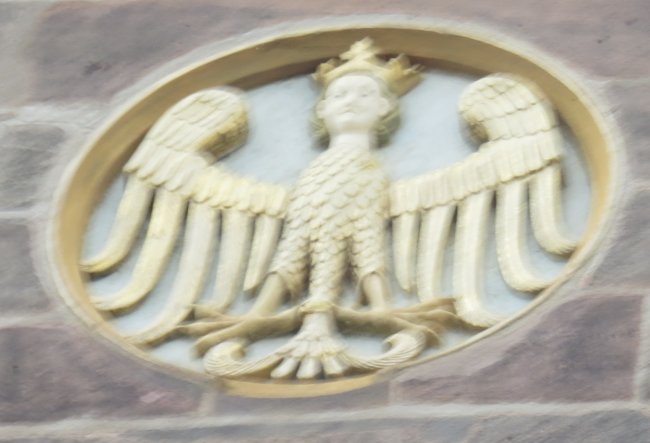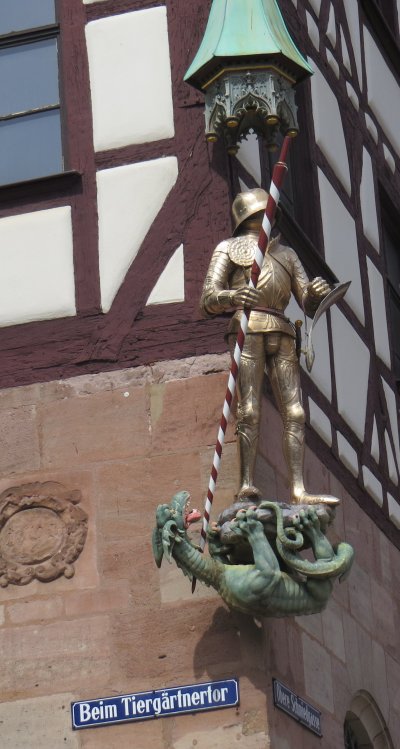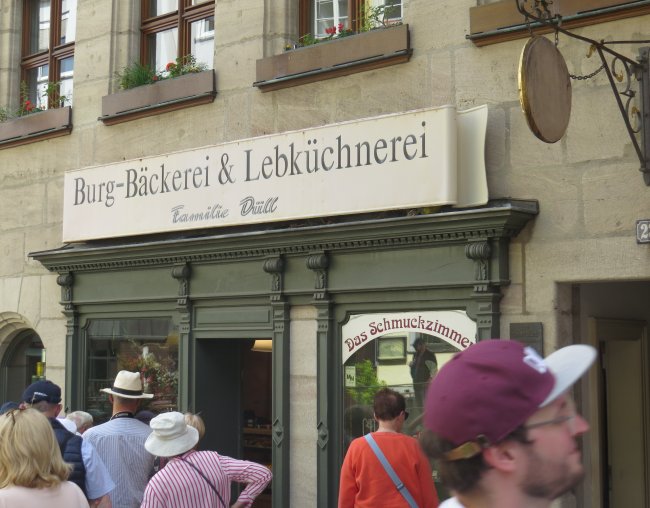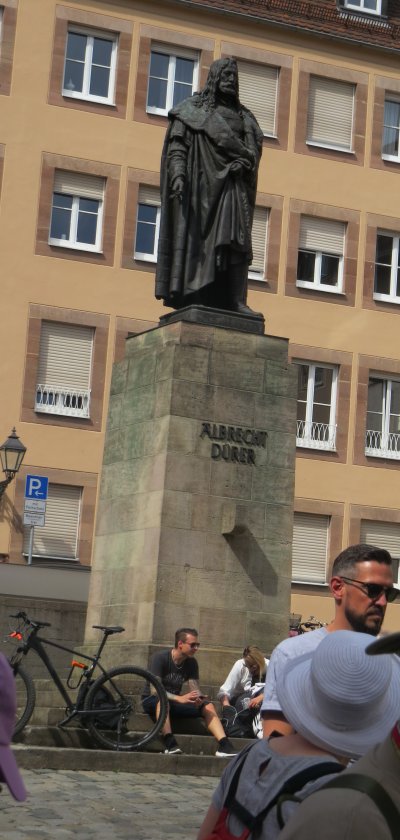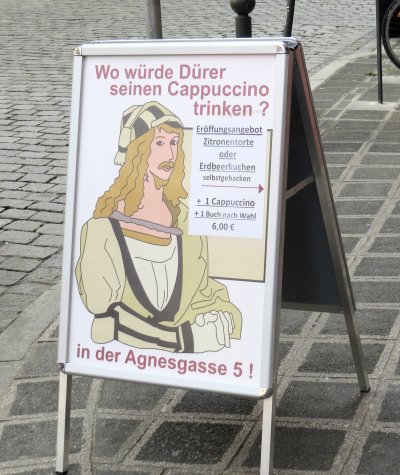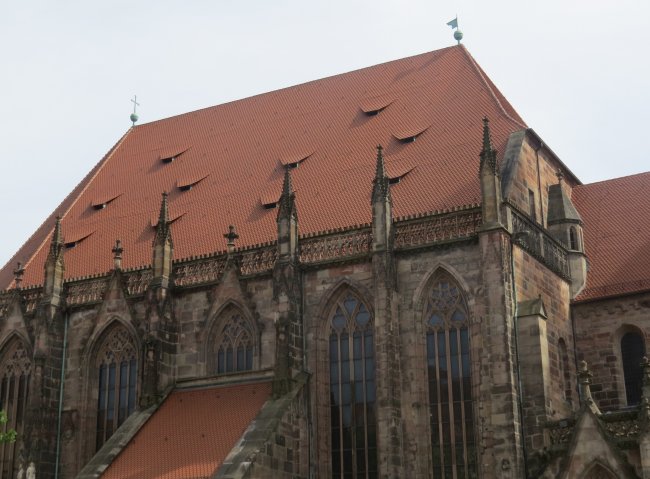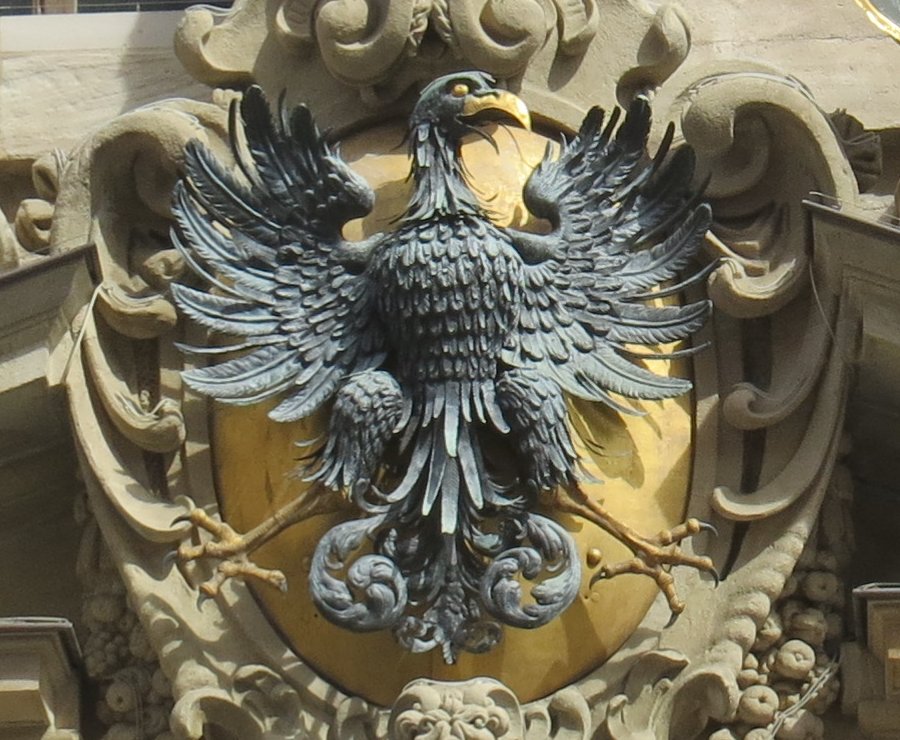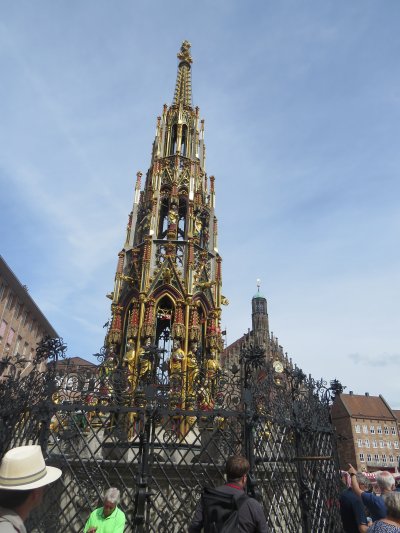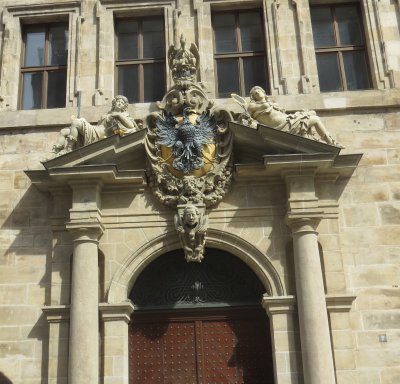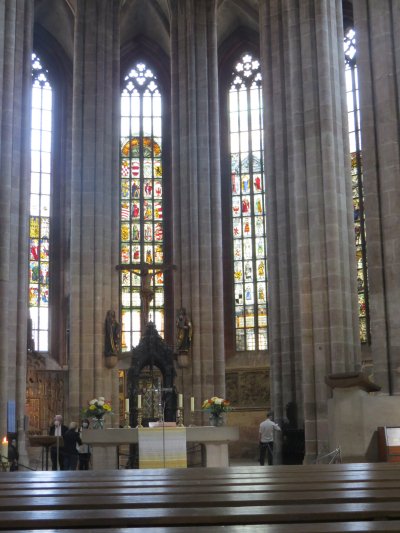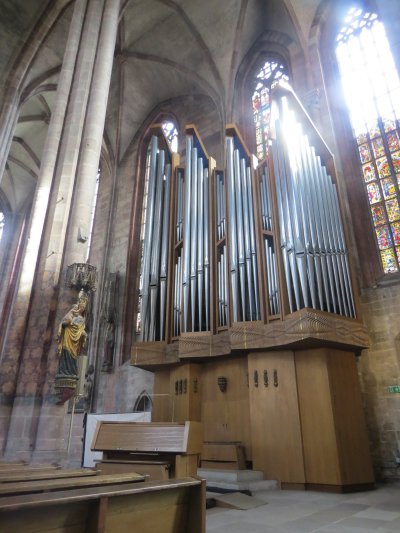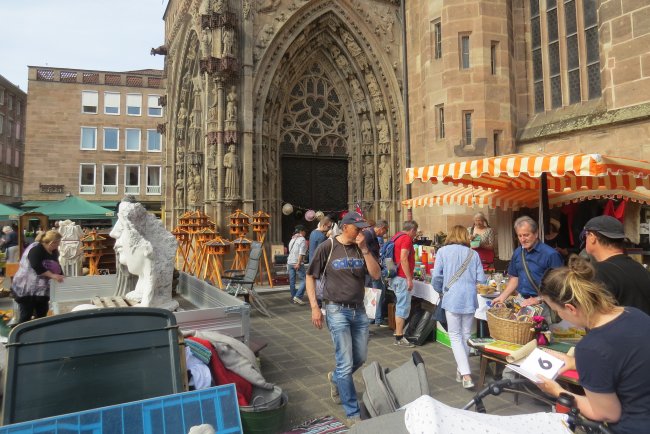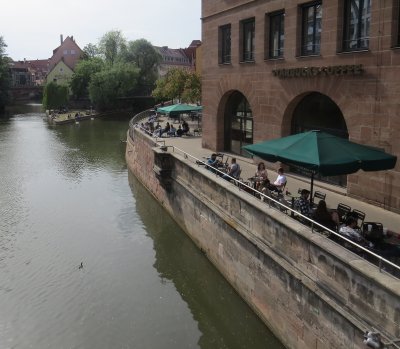Before the excursion: : I slept soundly after I sent the email late Thursday night. I did not get out of bed until 6:30, which was quite late for me in any circumstances. The bed was very comfortable, but I must have slept wrong on my left ankle. It was so sore at first that I could barely walk, but the pain quickly dissipated, and it never returned.
My priority for the morning was to gather together my laundry. Nuremberg was, by my reckoning, the midpoint of the trip. I had planned to bring enough clothes only to reach Nuremberg. I was depending on Viking (or someone) to wash my clothes for the second half. I wore the non-bloody pair of jeans, a shirt, underwear, and socks. I left my two pairs of dress pants in the closet. I also threw away two pairs of threadbare socks. Nearly everything else went in the laundry bag.
Aaaargh! The flushing mechanism in my stateroom's toilet was not working. I called the desk and reported it. I was assured that an "engineer" would fix it forthwith.
I tried to make sense of the schedule of activities for the day. We would arrive in Nuremberg (spelled Nürnberg in German) at about 9. Two things were scheduled for 9:15: a shuttle bus that would transport people to somewhere in the city and the excursion entitled "Surviving the War—Art in Nuremberg", for which I did not enroll. It did not previously occur to me that this tour finished before the included tour, "Nuremberg Through History", began. In fact, the end of that tour was only a little more than an hour before the ship was scheduled to cast off for the journey to Bamberg.
So, there were two ways to see the city on your own: You could go on the art tour (which was really a cellars and tunnels tour), eat lunch, and then go exploring while the other tours were operating. The only alternative was to take the shuttle bus in the morning without any prior guidance at all.
I was totally unprepared to go out on my own in the morning. If I had realized a day or two earlier that this bass-ackwards order would be imposed, I would have tried to plan a more constructive use of the morning.
I filled out the form for the laundry. I left it with the laundry bag on my bed and went upstairs to eat breakfast. Marty and Boris were there.[1] I asked if I could join them. Marty asked me not to. She said that she was paranoid of Covid. Ten people had already been taken off of the ship because of positive tests.
I was definitely taken aback by this episode. I ate breakfast by myself. Through the restaurant's windows I could see people walking and biking on the paths along the canal. The ship was moving, but very slowly. We barely passed the walkers, and the bikers zoomed past us.
When I returned downstairs the room was made up, the laundry bag was gone, and the toilet bowl contained nothing but water.
After breakfast I discovered that I had received an email from Sue. It had some information about the mail delivery and what she had been up to. It also included the following two paragraphs.
I will investigate options for face-timing with you & Yoda[2] and send instructions. Can we pick some time on my Saturday to meet online? I am busy most of Friday while you are awake. Saturday I am doing nothing. Sunday I have HBC Swiss game.[3] Please email me with some suggested times.
I would ask "Guest Services" if they may have a phone charger (even a wireless one) that you could borrow and use to get your phone charged to at least 80%, then save it for our rendezvous at Logan.
I googled "Pixel 2 wireless charger" and discovered that my cellphone does not support that method.
I replied via email that I was usually free around 6 p.m., which was noon her time, and after supper, which would be from 2-4 p.m. her time. I did not say anything about the phone. I did not trust the people at the desk to solve the problem. Maybe I could find a German store that specialized in them. I was thinking of something akin to the kiosk in the Enfield Mall.
I then concentrated on Nuremberg. I watched a Rick Steves video about Nuremberg, but it did not enhance my knowledge much. I did not know where anything mentioned was located. I also did not know how to move between one location and the next. I wrote in my notes that "I think that the four-hour tour in the afternoon should be enough."
The city was much more intimidating to me than the previous three ports. It was ten times as big as Passau and three times the size of Regensberg. It was more than a mere historical attraction; it was home to half a million busy people. I didn't realize it at the time, but the docking location for the ships was not even on the map that was available at the reception desk. It was shown in an inset in the lower right corner, which would have been at least four miles from the area shown on the map.
This had also been a problem on the Viking Russian tour that we took in 2011. The docks in both St. Petersburg and Moscow were so far out of the city that it was difficult, if not impossible, to explore on one's own.
I decided to take neither the art tour nor the shuttle bus at 9:15. I may have been put off by the idea of spending $79 on the tour when I was already devoting roughly that same amount to laundry. So, for the first time in a few days I had a few hours of unstructured time on the ship.
I took a self-guided tour of Viking Vili. I hoped to find a comfortable place to work on my laptop. The lounge was not under consideration, but near it I discovered the espresso machine and made a cappuccino. I did not find a good work area. The library was very small and not well lit. One of the stairways to the top deck was open, and there were seats up there, but it did not appeal to me. So I just returned to room #100 and sat on the bed.
When I used the toilet it once again failed to flush. Not long after I reported the situation the engineer came to my room and worked on it for a few minutes. After that it worked fine for the rest of the trip.
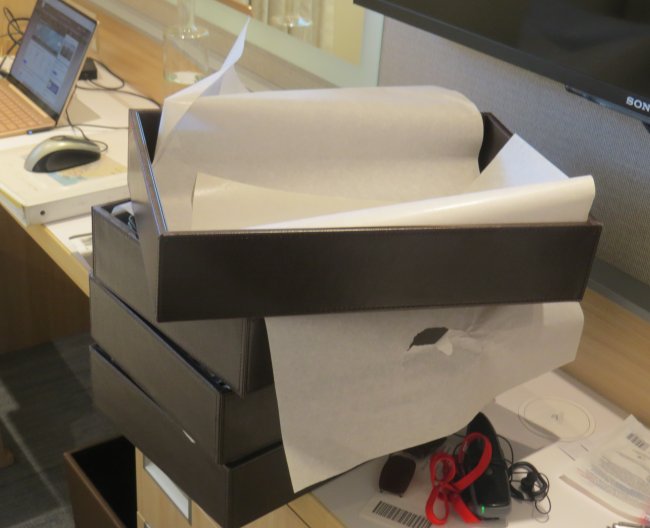
At a little after noon I walked up to the restaurant and ate lunch by myself. I did not record what I ordered.
When I returned from lunch I was surprised to find a pile of boxes in room #100. The staff in the laundry room had already washed, dried, folded, boxed, and returned all of my clothes! The blood-stained blue jeans looked as good as new. I put everything in the drawers and prepared myself for the excursion.I wore a sweatshirt, but I expected to take it off when the weather got a little warmer. I brought my ticket, my camera, and the digital recorder. I also brought the phone in case I found someone who might be able to diagnose the problem.
The bus and walking tour: : At least three or four groups took the included tour. As usual I was assigned to group #43B. Our guide was a rather brash young man named Johannes. He began by congratulating us for being "on the best coach. Well, if you were on the tour with us this morning, you are now on the second-best coach." He then introduced the bus driver, Roman. "He will take us safely through the city."
By the time that I started composing this page—about seven weeks after the fact—I remembered almost nothing about this tour. Fortunately, I recorded the first hour and two minutes that we spent on the bus. When we started walking Johannes switched to the QuietVox, and thereafter I was unable to record what he said.
Johannes informed us that he was not originally from Nuremberg. He came to study history and English at the university in Nuremberg and then stayed. He was employed by an organization called "History for Everyone." He said that we could ask him literally any question, as long as it was about dead people. I had a long mental list of questions about the relationships between the imperial court, the papacy, and monks in the eleventh century, but I don't think that others in our group would have been very interested in them.
Johannes began with a demographic summary: Nuremberg was the second-largest city in the largest of Germany's sixteen states. Many people from northerner Germany thought Bavarians were weird. Nuremberg was the industrial heart of the state. It became industrialized early in the nineteenth century. As he said this the bus passed a large factory that belonged to the Siemens Corporation, which employed 300,000 people worldwide.
In 2011 the government of Germany decided to phase out the use of coal and nuclear power plants. The goal was to transition by 2020 to renewable sources for 15 percent of the electricity. In fact, by 2020 renewables accounted for 50 percent. However, the country was still dependent on gas from Russia for heating.
We passed an Aldi's. Johannes said that they offered extremely cheap goods that were of good quality, but they had no service whatsoever. This approach proved very popular. One of the brothers who founded the chain was considered "the stingiest person in the world."
The Nazi party took power in Germany in 1933. They chose Nuremberg as the site of their annual meeting/rally. The official story was that it was chosen because of its historical and industrial past. Most historians now think that the decision was probably made because Nuremberg was a railroad center, and it would therefore be more feasible to bring hundreds of thousands of people there.
The headquarters of SS was built 1927-1939. The organization was within the army, but its leaders were responsible for most of the crimes, including the concentration camps. When the Americans captured Nuremberg they turned the building into a barracks. It was given back to Germany in 1994. It was then transformed into the headquarters of the Federal Bureau of Integration.
According to Johannes the rallies were held purely for the purpose of propaganda. We could just barely see a small portion of the rally grounds. I was, as usual, sitting on the left side of the bus, and the rally grounds were on the right. So, photography was nearly impossible.
The convention hall and other buildings were intended to resemble the Colosseum in Rome. Everything had to be much larger. The building was never even finished. If finished, it would have been almost twice as large as it appeared today. This was currently called, at least by historians, "The architecture of intimidation."
The Documentation Center's museum of propaganda and how it works was under renovation in 2022. It had 300,000 visitors in 2019, but it was only built for about one-quarter of that number.
Albert Speer, the leading architect of the Documentation Center, was only twenty-nine when he got the job. He also designed the Zeppelin Field, which we drove by next. We could see very little of it because of the trees and fences. Hitler spoke from the middle, but only to impress people, not to convince them.
The cost of what was constructed in Nuremberg would run into the equivalent of billions of euros. Germany financed this and all of its other projects, which included the autobahn and the build-up of the military, by borrowing from German financial and industrial institutions and from some international banks. Hitler admitted privately that he had no intention of ever paying it back. He said that the debts would be paid by "the subjugated people after we win the war."
Since the end of the war the educational system in Germany has emphasized the horrific deeds of the Nazis in an intense fashion.
We then drove by the headquarters of the Federal Bureau of Labor, which published the country's unemployment numbers. At the time of the tour they were at a record low. We then encountered a traffic jam as we headed toward the old central city of Nuremberg,
By European standards Nuremberg is a very young city. The first document with the word "Nuremberg" on it was from 1050. Emperor Henry III was visiting the area and signed a document that said that Sabina, an unfree woman could marry Richard, who was a free man. Nuremberg was thereafter the nexus of trade routes.
We passed the technical university named after Georg Simon Ohm. Nuremberg was very rich until in 1625 the town council voted to become the first Lutheran city in the Holy Roman Empire. From then on the city was shunned by the emperor. It was very poor in the seventeenth and eighteenth centuries. There was no new construction; everything was left as it was with intact city walls. The largest part of the city walls are still original, dating back to the thirteenth century.
About 93 percent of the city center was destroyed in World War II. The Opera House was the most expensive in the world when it was built in 1903 after Nuremberg became rich again because it had become the center of industrialization.
When the train station was built everything had to be imported from England. The driver even had to be imported from Scotland. The first train ran to the neighboring city of Fürth, which is the birthplace of Henry Kissinger. He used to return to his hometown pretty often. He never spoke proper English because, according to his brother, "he never listens." His first name is really Heinz.
There has always a big rivalry between Nuremberg and Fürth, which is downstream from Nuremberg. For centuries waste was poured into the small river that connects them, the Pegnitz. When the two clubs played each other in soccer the fans went crazy even though neither team was ever very good.
The Nuremberg courthouse was used for the post-war trial because it was one of the few courthouses in a major German city that was not destroyed. The trial was held in room 600 in the east wing. Twenty-one people were prosecuted by the International Military Tribunal. Twelve were executed. Three were acquitted. Since 2020 room 600 has no longer been used for trials.
The basic principles under which the IMT trials were conducted were still used by the International Criminal Court in the Hague. The thirteen basic principles of international law were drawn up by Robert H. Jackson, an American. The trial drew together all of the available evidence to prove that the holocaust really happened, and these people were responsible. In Germany denying the holocaust is a criminal offense.
The nearby prison was still standing, and that was another reason that Nuremberg was chosen. Next to it was a school that was located between a prison and a brewery.
Nuremberg had about 8,000 Jews in the thirties. Most emigrated to the U.S. and elsewhere. About 1,600 remained. Only 72 survived the holocaust.
The Jewish cemetery somehow survived the war, as did the Lutheran cemetery, St. John's, which some years ago was voted the most beautiful cemetery in Europe. All of the famous residents of the city are buried there.
The Imperial Castle featured two flags: the blue and white of Bavaria and the red and white of Franconia. The inhabitants of Nuremberg still identified as Franconians rather than Bavarians. Napoleon gave Franconia to his friend and ally, the King of Bavaria. There was also a German flag, but almost no one noticed it. I did.
I remember only a few details provided by Johannes during the walking tour. He thought that it was very peculiar that Nuremberg's symbolic eagle seemed to become more and more feminine over time.
At the very end he showed us another insignia that was somehow connected to four capital letters. I don't remember the letters, but one was Q. I asked him what the four letters stood for. He tried to twist them into something like SPQR, but in the end he was stumped. He said that he would find out what it meant. I later gave him my calling card and asked him to email the answer to me, but as of August 23 I had not heard from him.
I spent part of the free time making a half-hearted effort to find a store that specialized in cellphones. There were probably several such stores in such a large city, but none of them were evident in the touristy area. Then I walked to the meeting place near the castle.
At the castle the other buses were parked directly behind our bus, 43B. Although the bus had been at most 70 percent full on the way to the city, there were only two empty seats when I boarded well before the designated time of 5 o'clock. The unoccupied seats were across the aisle from each other. I took one of them. The woman across from me nicely offered to switch seats so that I did not have to sit with her husband. I cannot explain why so many people had gotten on the wrong bus. It was annoying to be packed together for such a long bus ride. I probably should have just gone to a different bus, but I was tired and cranky.
After the excursion: I did not buy anything in Nuremberg. I resolved to find something to buy in the next port of call, Bamberg, just so that I would have some smaller denominations to use as tips for the guides.
I discovered that it was possible to listen to classical music through a special channel on the television. There were many good selections, but the arrangements were weird.
I had another very pleasant supper with the people from Saskatchewan. I ate a Caesar salad[4], moussaka, and bread pudding. I only ordered the moussaka because it has long been one of Sue's favorite dishes, although, if truth be told, I think that she only really enjoyed it once when we dined at a restaurant in Detroit's Greek Town back in the seventies.
I don't remember that the day's excursions came up in our conversation over supper. Denise was a more active contributor to the conversation than she had been previously. She asked me if I had heard of David Sedaris. Of course, I had read several of his books. She referred to something in one of his books, but I don't remember what.
I told Ed that I had discovered that Martha Stewart's gigantic (by New England standards) rural estate was actually in New York, but it was very close to Connecticut. I am sure that for someone from Canada this was a distinction without a difference.
We talked about graffiti, but I do not remember the details. I learned that Steve's business was the sale of agricultural products. We somehow also got into the subject of old computer code. Steve had had quite an experience keeping code that did just what he wanted maintained through the years.
Someone said that they had heard that two couples had been escorted from the ship because they tested positive. In the 6:45 announcement Gary Nicholson had said that there was only one new case.
Sue sent me an email that our town of Enfield had reported 165 new cases in the last week. The risk of infection in Hartford County was now rated "High". I wondered if the Hartford Bridge Club would reinstate the mask mandate
Gary had claimed that the musical entertainment at 9 o'clock would be a combination of classical and Franconian music. It was actually a duo playing klezmer music. Fortunately I did not attend.
Evaluation: I assume that Viking must have had a good reason for scheduling the art tour in the morning and the others in the afternoon. The included tour was all right. I thought that Johannes did a pretty good job of making it interesting. I wonder what the historical tours did. Perhaps they let the passengers get off the bus once or twice.
I also wonder how many people were brave enough to take the shuttle bus in the morning. Maybe that would have been good for someone who had already been to Nuremberg and wanted to visit someplace special that they had missed or really enjoyed previously. I did not have the guts to venture out on my own. If I had it to do over again, I think that I would have taken the morning tour and tried to contrive a way to go to the Germanic History Museum in the afternoon. If that were not feasible, I probably would just stay on the ship. I would have wondered what I missed, but I suspect that others would have told me, "Not much."[1] I never saw Marty and Boris again after this event. I am quite certain that they left the ship at some point between Nuremberg and Cologne.
[2] I called my previous laptop Yoga because that was Lenovo's name for that model of a convertible. For some reason Sue has always thought that its name was Yoda. Even if it was, that computer spent the seventeen days of this trip on the dresser in the bedroom at home.



